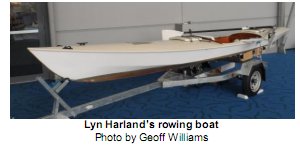Coochiemudlo Messabout July was a very busy month with both Matthew Flinders and Caloundra events. The Matthew Flinders re-enactment at Coochie Island was a great week-end again with perfect winter weather about 22 deg daytime to 10 deg overnight with good sailing breeze on the Saturday but very light on Sunday. As the re-enactment is on the Sunday we spent most of the time on the beach. The Wooden Boat Pirates were there again and the distribution of lollies to children from the treasure chest was very popular.
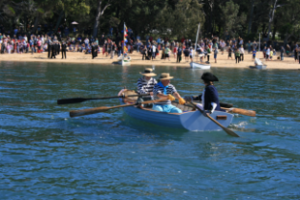
Pat and I stayed at the Seminara units and Libby and Ian joined us for dinner there on the Friday night – great venue and good food. Saturday night, Libby and Ian hosted a roast dinner at their cottage for a total of thirteen members including 4 wives. This made for a truly family week-end and would recommend more wives attend next year.
Caloundra messabout
Caloundra messabout hosted by the Caloundra Coast Guard is always the highlight of the year.
This has always been the most popular event with our members and wives (too many to mention individually). Once again, we had the Meet and Greet at the Coast Guards building Friday night and Saturday a sail down the passage to Roy’s and Lighthouse Reach Point. There were over twenty boats, sail, power, even row, but with tide and quite a strong Northerly it was an easy sail. Following morning tea on the beach it was quite a testing sail back as the channels are very narrow, not very well marked and it was not easy to see the sand banks.
After lunch we held the Russell Lanigan trophy “race” won this year by Bob with Ian as crew. With such a mixed bag of boats, it is really just a bit of fun, similar to the Bribie Island “race” and not to be taken too seriously.
SUNDAY:
Quite cloudy in the morning but we had a good sail to the Blue Hole North of Golden Beach on Bribie side for morning tea. Following that with the locals guiding us through the sand banks, we sailed up the passage towards the Bar. The Caloundra guys, who obviously know the waters well, sailed to just inside the breakers but with an incoming tide, it was quite safe. We then sailed back to Golden Beach for lunch and more fun races for putt putt and rowers; the weather had by then cleared and it was a lovely sunny day again. A great week-end.
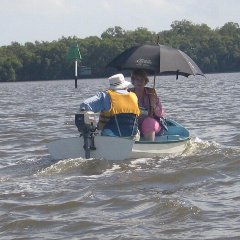
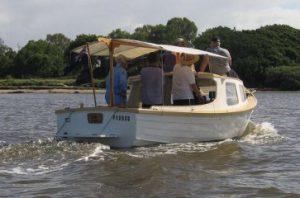
Thanks to Caloundra Coast Guard for the organisation, they even provided safety boats. With many choices for accommodation and restaurants, it makes a great location for a family week-end and it was good to see so many wives present. We look forward to the event again next year.
10th Tweed River Regatta
It rained Then it rained. And it rained some more, The event was a triumph of the human spirit over adversity: Bit of a dampener and an organizer’s nightmare, but being resilient boat people we all persevered in some form of other and had a great time. I recall someone saying these events are not only about boats but the meeting, reminiscing and enjoying each other company; this was one of those occasions.
Friday night started off with a well organized cruise on “Golden Swan” a lovely old wooden cruise boat I believe built by Normal Wright. The Wooden Boat Association Qld sponsorship donation of $250 was well spent on food and an extended cruise. Leaving the Tweed marina we travelled to just past Chinderah park before turning heading down towards the Fingal end of the river and then back to the Tweed River cruise terminal. It was good to see this meet and greet well attended and Bob and Bruce welcomed all and briefed us on Saturday’s activity. It was only then most of us Queenslanders realized that an 8.30 am start was in reality at 7.30 am start, bugger.
So did Saturday dawn bright and sunny? Unfortunately no, rain more rain and occasional showers greeted us all. 43 boats had entered the regatta of these only around 20 hardy skippers put to the water for the cruise to Tumbulgum and onto Murwillumbah Rowing club. This had some benefits for instance “TIKI” and enclosed launch took on board six of the not so hardy souls, but who remained warm and dry, and along with the skipper had a very delightful run up the river, great company makes a great event.
The rowing club soon had its banks lined with wooden boats from a large ex Cray boat from Tassie to a right yellow sabot. Which we happened to see belting down the road on the back of a ute then in the afternoon sailed home. At the rowing club we all enjoyed a sausage sizzle and admired the rowing skiffs and for some us the lovely wooded rowing skiff hung upside down fully rigged in the club room. The rain cleared but only for a short while, long enough for us all to make a start on the return journey down this lovely river, lined with mangroves, palm trees and glimpses of the canefarms. On a fine day it would be just a magical spot to meander by.
Saturday night we all gathered again, and a great crowd too, at the Chinderah Hacienda caravan park function room for more reminiscing and for a great spit roast dinner well compared by Dave along with the formalities of the weekend. Every boat was recognized and given a Brag Plaque, Gem of the Tweed trophy went to a beautiful speed boat “Saraya” built by Joshua who happens to live a long way from the sea and the WBAQ encourage award we gave to Ross and his launch “Bonnie Harper”. Ross found the hull lines in a Wooden Boat magazine and that’s all he needed the rest evolved into a comfortable boat.
It’s tough organizing any event and everyone recognized the hard work put in by Bob who is standing down as President of the event so well done to Bob and all of those who helped to organize the past 10 years of regattas. We look forward to next year’s regatta and perhaps even a run in between times down the Tweed River.

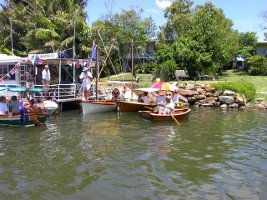
Wivenhoe Messabout
Once again our planned week at Wivenhoe was cancelled as all the boat ramps and parts of the camping area were under water!!
PLAN B was again adopted and we went to Atkinson Dam. This now makes 3 times this year but for a generally wet year we had very good weather – just a little rain on Wednesday morning. We had an excellent attendance with 14 members and their boats and also a visit by Ross Lillystone with a Phil Bolger Micro one day making 15 in all. It was good to see Rick Sutton’s new boat a Welsford “Navigator” and John Holland’s version of Jim Inglis own design Gert by Sea. Both boats had an excellent finish and it was interesting to see how John had fitted out Jim’s design to make it hard to recognise that it is the same design boat. The advantage of building your own boat is you can incorporate your own ideas and make most boats individual.
Victoria Point.
Members launched at various locations and met up at Thompson Street beach and picnic area to enable anyone to turn up there and go for a sail on any boat. Although the weather was perfect, we only had 8 boats and as far as I am aware only Ian turned up and went for a sail with Larry. It was interesting to go to a different beach and check it out. This is one of the advantages of messabouts. It’s an excellent spot to pull in to for lunch, shade and toilets but you do need to time it for high tide. It was good to see our members from Coochiemudlo and Mackay Island sail over as it is difficult for them to attend most events.
Noosa 5th, 6th, 7th November.
We timed this messabout to coincide with the Noosa Classic Boat Regatta which some of our members attended. As planned, we held the Happy Hour. Meet and Greet with a BYO BBQ at Coco Bay Resort. We had a total of 12 (6 couples) and had a very pleasant evening (see photo).
Saturday we launched and motored up river. I rigged my sun canopy – African Queen style and Don was my queen!! It was interesting to see the North shore river side homes and varied boats. We then followed the classic boats, mainly power, downstream to their lunch spot at the Noosa Yacht Club. We continued on and pulled up at a lovely quiet beach near Noosa Sound. Late afternoon we drove round to Martin’s “shed” to see his progress on the Tasmanian Ferry boat built l917. It really is a lovely shaped hull and he is doing a truly great job of restoring it. There is a massive petrol engine, also an electric motor to start the engine but also to give 4 hours that he can sail under electric power. A very clever guy, he leaves me speechless. An eye opener is his unit in an industrial complex that he calls a “shed” room for free standing thicknesser, router table, bandsaw, large table saw, drop saw and an air conditioned office !! I guess if you are going to take on a major restoration, these are the type of facilities you need. After a very pleasant Happy Hour again at Coco Bay, we had reserved a table at the Yacht Club and had a great meal there.
Sunday we motored around Noosa Sound with another great spot for lunch, then pulled out early as some were returning home. For the four couples who stayed over Sunday night it was fish and chips from the local shop and Happy Hour first at Coco Bay. It was a very social week-end rather than all boating and all wives really enjoyed it. It was unanimously agreed same again next year.
Pine River messabout, Deep Water Bend ramp:
With a forecast of showers and often a week of very heavy rain and floods, I was surprised to see a good turn out before 8.00.a.m.to our first messabout of the year. Skippers rowing were Dan, Ian, Darrell, who took off early down river towards the new Hornibrook bridge with the remainder of the fleet leaving the ramp by 9.00.a.m. sharp. We stopped on the south bank within site of a bridge for morning tea. Alan with a young crew joined us there raising our numbers to nine (9) boats with a total of 20 members. This must be a record for a messabout. There was no shortage of company as Larry had 4 on his Mirror 16 and Ian had 6 on board Tiki who I had joined. This was my first time on boat and a very pleasant and comfortable way to travel and a chance to appreciate the boat that Alan had built. I was most impressed at how disciplined Ian’s regular crew Charlie is; when Ian’s neighbours hat blew off we practised our man overboard drill but as we got close it started to sink. Charlie dived overboard fully clothed and rescued it (but it was about 30 degrees!!). Then a little later the putt putt suddenly stopped, Charlie said “I’ll give it mouth to mouth” and I thought he was joking but then he took the top off a little tube near the transom and started to blow !! Ian cranked the motor a couple of times and away we went ! I can’t do that with my Tohatsu outboard. We then travelled up river with the tide and Mack joined Ian for 2 up rowing; I estimated they were doing at least 4 knots. It was good to see the Catspaw dinghy on the water; this really is a nice looking boat that Alan has built with an inboard motor but I’m sure it would also look good under sail. Remember the club has the strong back and moulds for hire for our members to use.
We managed to find shade on the river bank for lunch and headed back to the ramp as the tide had changed in our favour. We were back for 2.30.p.m. as that’s long enough on the water at this time of year. After a final cup of tea, we were away by 3.00.p.m. A very pleasant day with a great collection of boats.
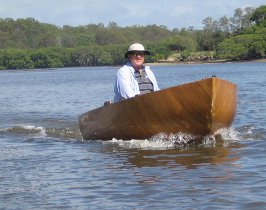
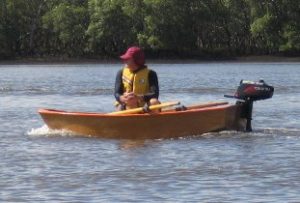
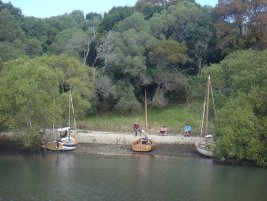
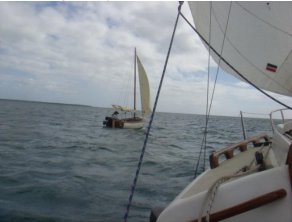
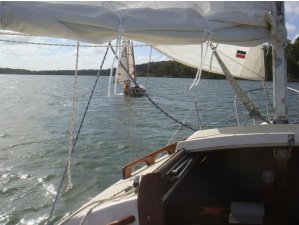
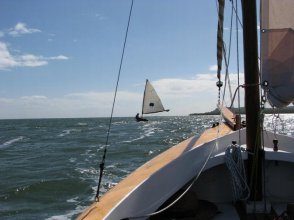
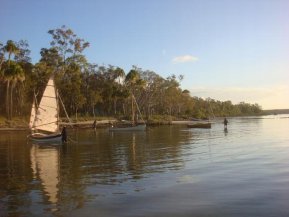 Garry’s anchorage is a great spot. We beached the boats on sand and spent the evening working out how we would get back to Carlo Point if the strong southerly wind continued to blow. Wednesday morning we had to head south against a weakening southerly and, in the morning, the incoming tide. We were making for Tinnanbar on the mainland side of the Strait. This plan went well apart from a short spell in the middle when the southerly wind kicked up to around 20 knots before swinging around to the southeast giving us a good long reach across to Tinnanbar.
Garry’s anchorage is a great spot. We beached the boats on sand and spent the evening working out how we would get back to Carlo Point if the strong southerly wind continued to blow. Wednesday morning we had to head south against a weakening southerly and, in the morning, the incoming tide. We were making for Tinnanbar on the mainland side of the Strait. This plan went well apart from a short spell in the middle when the southerly wind kicked up to around 20 knots before swinging around to the southeast giving us a good long reach across to Tinnanbar.



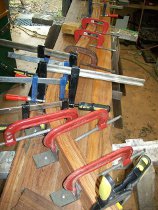
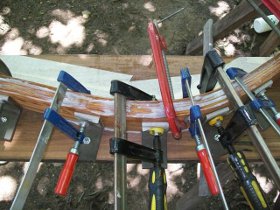
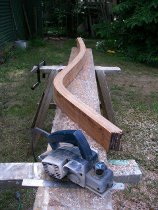
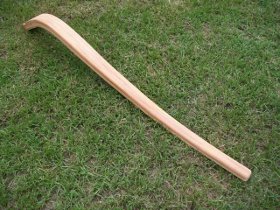

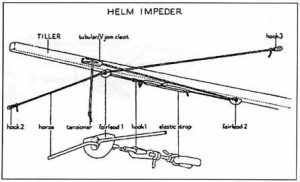







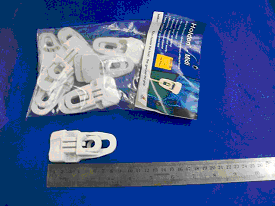
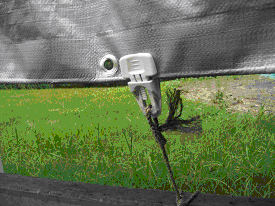
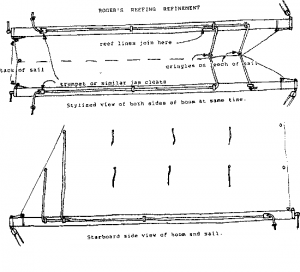
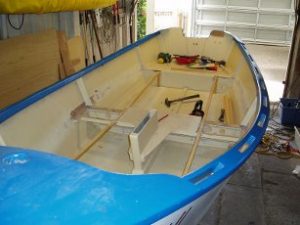
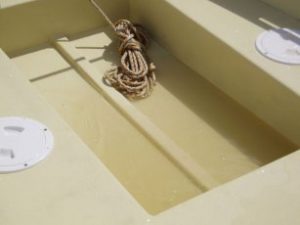
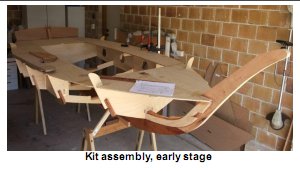
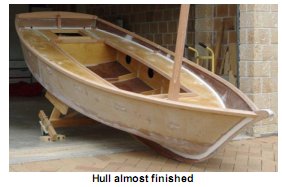
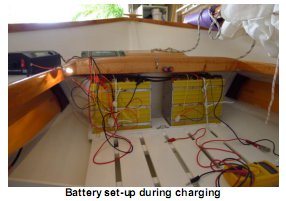
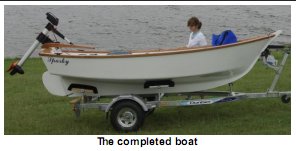
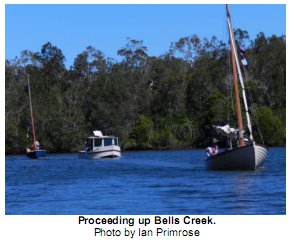 Our decision to explore Bells Creek was a great success, Billy our local connection guided us through the very shallow entrance then it was quite deep for approximately 8 km up a very quiet and peaceful creek.
Our decision to explore Bells Creek was a great success, Billy our local connection guided us through the very shallow entrance then it was quite deep for approximately 8 km up a very quiet and peaceful creek.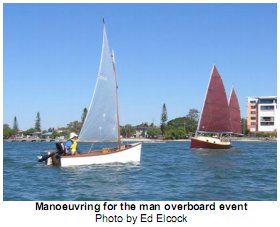 In lieu of a man, a life jacket was thrown over near the committee boat and time taken to retrieve under sail. This was not heavily contended but as there was a bottle of Port for the winner, Geoff Williams with Don Burrows as crew were first to have a go and set an unbelievable time of 1 minute.
In lieu of a man, a life jacket was thrown over near the committee boat and time taken to retrieve under sail. This was not heavily contended but as there was a bottle of Port for the winner, Geoff Williams with Don Burrows as crew were first to have a go and set an unbelievable time of 1 minute.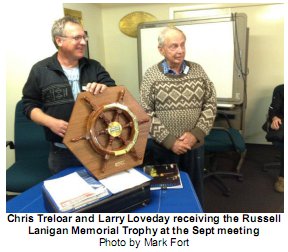
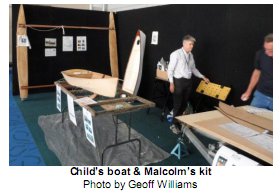 So many visitors said “My dad used to have a boat with one of those motors”.
So many visitors said “My dad used to have a boat with one of those motors”.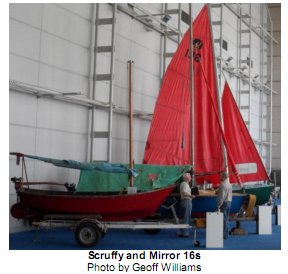 Our thanks to all Members who came in to man the stands and help with the stitch and glue demonstrations. I am sure once again we will get more new members and encourage others to build a boat that they have always wanted to do.
Our thanks to all Members who came in to man the stands and help with the stitch and glue demonstrations. I am sure once again we will get more new members and encourage others to build a boat that they have always wanted to do.